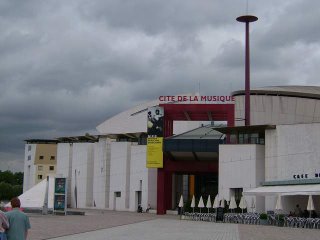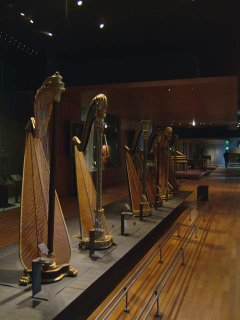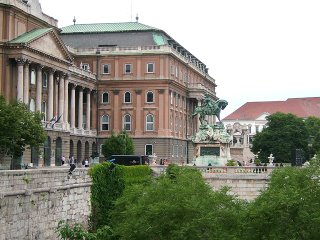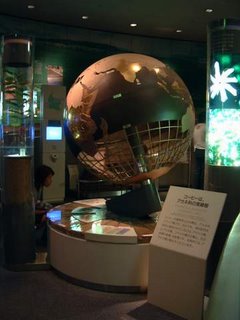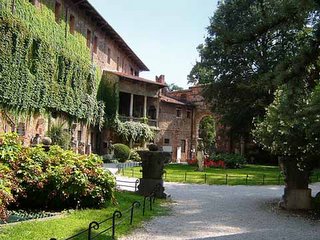
孤陋寡聞的我,其實是一直到某次不小心在網路上找到這個博物館的網站,才知道泡麵確實是台裔日人發明的,不過不知道為什麼,到目前為止我對這件事情還是有點半信半疑…
I found this museum by accident on the internet. Not until then, I didn't know the instant noodle was invented by a Taiwanese Japanese. For some reasons, I am still suspecious about the fact even now.
這一座於1999年開放的紀念館,是世界上第一座以速食麵為主題的博物館。背後的日清食品,與泡麵的淵源非常深遠,因為泡麵這東西,就是日清食品的創始人安藤百福在1958年所發明的。這座兩層建築的紀念館,主要就是在介紹泡麵的發明與發展,第一層為接待處與展覽室,第二層則是活動教室。
The museum was established in 1999. It is the first museum of instant noodle in the world. The founder, Nissin Food Products Co., Ltd., has had a very long relationship with instant noodle. Actually, instant noodle was invented by the founder of the company, Momofuku Ando, in 1958. In memory of Ando, this two-floor museum was built. Its purpose is to introduce the invention and development of instant noodles. The first floor includes reception area and exhibition hall, while the second floor is mainly activity room.
入館後很高興地發現紀念館免費開放參觀,不過當我和表妹兩人詢問有關泡麵製作體驗活動的時候,卻發現名額全被之前來的小朋友們佔滿了,心裡不免感到遺憾,不過這種活動總有個先來後到,我們也沒有辦法等到下一個活動時間,所以只好讓它成為當日的第一個遺珠之憾。
My cousin and I happily discovered that the museum offers free admission. However, when we inquired the activity of instant noodle making, we were told that only limited number of visitors can participate the activity and it was full booked already. It's such a pity. We couldn't afford to wait until the next session, so it became the first "regret" of the day.
一進入展示廳,馬上就被中央的草屋給吸引,上前一看,猜也知道這是在陳設安藤百福發明泡麵當時的環境。我每次遇到這種生態造景就很沒輒,進去也不是,不進去也不是,裡面的東西要碰不敢碰,東西看起來要真不真的…最後還是悻悻然地走了出來,這間小草屋其實也沒有什麼太特別的地方。
The diorama of a shabby house in the center attracted my attention when we entered the exhibition area. It is a reconstruction of the environment where Ando invented the very first instant noodles. I wasn't very keen on this kind of exhibition, because I always got the feeling whether to enter or not, whether I can touch the set or not, and the objects somehow look unreal. I came out of the tiny house in disappointment. There is nothing too special about it.
接下來看到的東西就真的很有趣了。左半邊的牆面是一條很常的時間線,配合日本國內重要大事發生的時間道出日清食品的發展史。在時間線的最前面,有一堆泡麵和紙箱,從小在日本長大的表妹告訴我,這是日清食品推出的第一種泡麵,如此說來也就是泡麵之祖囉!漫步讀著,來到展示廳的另一頭,偌大的白色牆面上連續地播放著影片,看了一下,原來是在講杯麵發明的故事啊!整個看下來,才發現原來這也是挺有學問的,麵的形狀要怎麼樣做、什麼樣的配菜、杯子要用什麼樣的材質,都經過縝密的思考研究…吃泡麵就吃泡麵,來這邊之前其實根本不會去想這些,這次也許又讓我體會到,生活中習以為常的事情,實際上也有著許多的小聰明小智慧在裡面。
The following part of the visit was really interesting. On the wall in the left hand side, there's a very long timeline, introducing both the important event in the Japanese history and the history of Nissin company. At the beginning of the timeline, there're many packs of instant noodles and some carton box. My counsin, who grows up in Japan, told me, it is the very first kind of instant noodle that Nissin produced. Walking around the area, I arrived the other side of the exhibition. Films were projected on the white wall. I took a closer look. It's telling the story of the invention of instant noodle. After I finished watching the film, I finally realized there's also very "profound" knowledge in it. The shape of the noodle, what kind of dried vegetable to use, what kind of material for cups, etc. all need to be concerned and checked. I've never thought of it this way, coz instant noodle is just too common in my life. I came to understand that there's always something smart out there, even for something very common in our lives.
看完影片,我們倆在一台沒有人使用的觸碰式螢幕前坐了下來。這裡有許多節目可以選擇,我們依序看完了泡麵的製作過程(十一個步驟)、日清食品暢銷商品的秘密、泡麵的煮法與吃法(還可以列印食譜)等,然後玩玩有獎問答,高興地拿著獎品兌換卷往下一區前進。(不會講日文的我怎麼有獎品?嘿嘿…當然是聰明的表妹連續玩了兩次幫我拿到囉!)
After we finished the film, we sat down in front of a touch screen monitor. Many programs can be chosen. We watched the sequence of instant noodle production (11 steps), the secret of popular Nissin products, how to cook and eat instant noodle (with recipe to be printed), and then played the quiz. I don't know a single Japanese word... and how did I win the prize? Well, of course, with the help of my counsin, I could also receive a souvenir from the museum.
在這些觸碰式螢幕的周圍有幾個展示櫃,是蠻容易被參觀者忽略掉的地方(因為根據我的觀察,一般人通常在螢幕前玩一玩就走了…)好奇的我們上前一看,原來是展示著在世界各國賣的泡麵,說明各大洲各國的產品有些什麼不同點,這時我才知道,除了可以想像地到的配料和口味以外,原來麵的長短也不一樣,亞洲的比較常,美洲歐洲的都比較短,據說是因為飲食習慣的關係。
Exhibits around the touch screen monitors are easily neglected by the visitors. According to my observation, most visitors leave the area after they finish the touch screen program. Curious as we were, we stepped ahead and found that it's an exhibition of various products sold in different countries. It explains the characteristics of products in different countries. For example, the noodle is longer in Asian countries, and longer in Europe and America due to dietary habits.
另一側牆上貼滿了泡麵的包裝和盒子,展示的是日清公司從創辦以來推出的所有產品,下面則設了兩個螢幕,不段地播放從前的泡麵廣告,走道旁還展出公司針對泡麵所推出的各種週邊商品,不禁讓人佩服日本人的生意頭腦。在這「麵牆」上看到的眾多產品中,最令我訝異的大概就是義大利麵的泡麵…搬到義大利以後,我對義大利麵也變的和義大利人一樣挑剔,實在是無法想像這東西到底怎麼做成泡麵,如果哪天有看到,真的會很想買來試試看。
The other wall is filled up with packages and boxes, showing all the products of Nissin company. Two screen under these products are broadcasting old advertisements. On the corridor, there're also peripheral products that were developed along with instant noodles. Japanese are so brilliant with their business mind! Among all kinds of instant noodles I saw on the wall, the most surprising kind is the instant spaghetti. After I moved to Italy, I became picky as Italians when talking about cooking pasta. I really can not imagine how spaghetti can be made into instant noodle. I will definitely try it if I see it in the market.
展示區的最後一個單元,展示的是日清食品與安藤百福曾經受頒的獎項,其中還有一個是有關於安藤氏對於世界飢荒所做出的貢獻。這個我真的覺得很有趣,因為我一直覺得泡麵是很沒營養的東西,不過當時忘了把那個機構的名稱給抄下來,所以…
The last part of the exhibition is about all the prizes Ando and Nissin received in the past. One is about Ando's contribution and help to solve world famine. This is very interesting, because I always take instant noodle as something innutritious. However, I forgot to write down the name of the organization that awarded the prize to Ando, so I've got no clue to do some further check now.
參觀完畢,也耗上一個多小時,所花的時間真的比我想像中的還久,上樓去瞄了一眼所謂的體驗活動,發現用看的實在是很沒趣,和表妹兩人就決定到接待處去買杯泡麵來吃(沒錯,真的有一區隨時都有熱水跟筷子,你只要買了泡麵,當場就可以在那邊泡來吃,我覺得這個經驗還蠻新鮮的。)唯一遺憾的,大概就是館裡沒有設賣店,如果裡面能夠買到日清食品全系列商品,我可能就真的會搬著大包小包的泡麵回外公家嚇人去了…
The visit took us about an house to complete. It's much longer than I expected coz the exhibition itself is not that big. We went upstairs to check the activity. It's not too interesting just looking at it, so we decided to go down to the reception and eat some instant noodles. Right, there's an area where the museum offer hot water and chopsticks for its visitors. You can readily prepare your own cup of noodle once you purchase it from the reception. It's quite a new experience for me. It's a pity that there's no museum shop. It will be wonderful to have a place where I can find every kind of Nissin products. If there's such "service" in the museum that day, I probably would buy lots of different stuff and move them all back to my grandpa's place.
PS. 紅色的文字是2005/8/30看了
時報週刊的非常人物以後改的, 原來安藤百福原名吳百福, 是台灣台南人!
I corrected the read word after reading an article about Ando in a Taiwanese magazine. He is a Taiwanese who emmigrated to Japan in his twenties. Wu is his original family name, from Tainan, Taiwan.


 1986年,Fehlbaum有了創辦設計博物館的想法,並於隔年與Frank O’Gehry進行接觸,邀請這位知名建築師來設計博物館。之後,Fehlbaum更與Alexander von Vegesack一起,將原本私人收藏展示的概念,發展成為一間對外開放的博物館。
1986年,Fehlbaum有了創辦設計博物館的想法,並於隔年與Frank O’Gehry進行接觸,邀請這位知名建築師來設計博物館。之後,Fehlbaum更與Alexander von Vegesack一起,將原本私人收藏展示的概念,發展成為一間對外開放的博物館。 除了博物館以外,因為參加導覽的關係,才得以進入Hadid和安藤替Vitra蓋的兩棟建築。這是我第一次體驗這兩位建築師的作品,其實是蠻新奇的經驗。Hadid的建築很有解構的味道,靈活的線條運用,規劃出很不一樣的外觀與空間。她利用線條創造出視覺上的錯亂,身歷其境的空間感,比實際空間大了許多、長了許多。另一方面,她更利用線條製造出流動感,即使站著不動,我還是不斷地覺得自己的身體左右晃動。
除了博物館以外,因為參加導覽的關係,才得以進入Hadid和安藤替Vitra蓋的兩棟建築。這是我第一次體驗這兩位建築師的作品,其實是蠻新奇的經驗。Hadid的建築很有解構的味道,靈活的線條運用,規劃出很不一樣的外觀與空間。她利用線條創造出視覺上的錯亂,身歷其境的空間感,比實際空間大了許多、長了許多。另一方面,她更利用線條製造出流動感,即使站著不動,我還是不斷地覺得自己的身體左右晃動。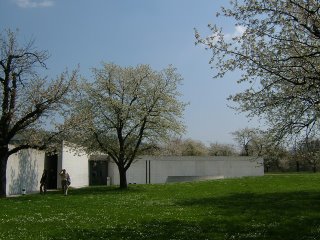 安藤的作品,則是另一種完全不一樣的感覺。在會議中心裡,有一種沉穩和諧的感受。導覽人員解釋著,構成水泥牆的單位與符合黃金比的榻榻米等大,往落地窗外看過去,會在外牆上看到一條代表著水平面的線,環繞著整棟建築物,以及特別光滑的牆面等,這些安藤所要求的細節,都是為了帶給使用者舒適感。看著窗外盛開的櫻花,竟然讓我感覺到一絲絲日本氣息。
安藤的作品,則是另一種完全不一樣的感覺。在會議中心裡,有一種沉穩和諧的感受。導覽人員解釋著,構成水泥牆的單位與符合黃金比的榻榻米等大,往落地窗外看過去,會在外牆上看到一條代表著水平面的線,環繞著整棟建築物,以及特別光滑的牆面等,這些安藤所要求的細節,都是為了帶給使用者舒適感。看著窗外盛開的櫻花,竟然讓我感覺到一絲絲日本氣息。